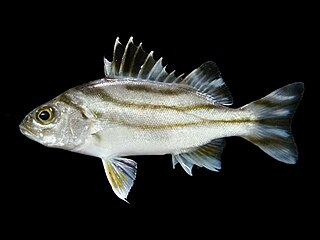
Grunters or tigerperches are ray-finned fishes in the family Terapontidae. This family is part of the superfamily Percoidea of the order Perciformes.

The Pacific staghorn sculpin is a species of marine ray-finned fish belonging to the family Cottidae, the typical sculpins. This species is found eastern Pacific Ocean. It is the only species in the monospecific genus Lepidocottus.

The southern school whiting, Sillago bassensis, is a common species of coastal marine fish of the smelt-whiting family that inhabits the south and south-west coasts of Australia. Its distribution overlaps a number of other common sillaginids, with careful observation of anatomical features occasionally needed to distinguish between species. The southern school whiting is closely related to the eastern school whiting, Sillago flindersi, and initially were thought to be all one species. The species inhabits both shallow inshore sandy waters, as well as deeper offshore waters, with a transition of habitats occurring with increasing age. It is a predatory fish, taking a variety of crustaceans, polychaetes and bivalves as prey. It reaches sexual maturity at three years of age, and spawns multiple times between December and April. The southern school whiting is commonly caught by commercial and recreational fishermen, often while fishing for related species, especially the sought after King George whiting. The species is marketed fresh in southern Australia.

The western trumpeter whiting, Sillago burrus, is a species of marine fish of the smelt whiting family Sillaginidae that is commonly found along the northern coast of Australia and in southern Indonesia and New Guinea. As its name suggests, it is closely related to and resembles the trumpeter whiting which inhabits the east coast of Australia and is distinguishable by swim bladder morphology alone. The species inhabits a variety of sandy, silty and muddy substrates in depths from 0 to 15 m deep, with older fish inhabiting deeper waters. Western trumpeter whiting are benthic carnivores which take predominantly crustaceans and polychaetes as prey. The species reaches sexual maturity at the end of its first year of age, spawning in batches between December and February The species is taken as bycatch with other species of whiting and shrimps in Australia.
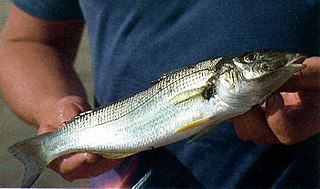
The sand whiting, also known as the summer whiting, yellowfin whiting or blue-nose whiting, is a common species of coastal marine fish of the family Sillaginidae, the smelt-whitings. It is a slender, slightly compressed fish that is very similar to other species of Sillago, with detailed spine, ray and lateral line scale counts needed to distinguish the species between its nearest relative Sillago analis. The sand whiting is distributed along the east coast of Australia from Cape York south to Tasmania, as well as Lord Howe Island and New Caledonia in the Pacific Ocean.
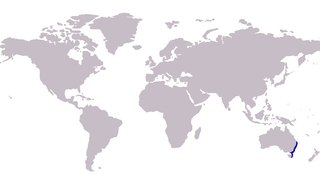
The eastern school whiting, Sillago flindersi, is a species of benthic marine fish of the smelt-whiting family Sillaginidae. The eastern school whiting is endemic to Australia, distributed along the east coast from southern Queensland down to Tasmania and South Australia, where it inhabits sandy substrates from shallow tidal flats to depths of 180 m on the continental shelf. Eastern school whiting prey on various crustaceans and polychaete worms, with the diet varying seasonally and throughout the range of the species. Eastern school whiting reproduce in the deeper waters twice a year, releasing up to 110,000 eggs during a season.
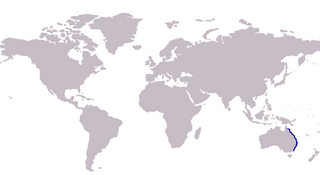
The trumpeter whiting, Sillago maculata, is a common species of coastal marine fish of the smelt-whiting family, Sillaginidae. The trumpeter whiting is endemic to Australia, inhabiting the eastern seaboard from southern New South Wales to northern Queensland. The species is found in bays, estuaries, coastal lakes and mangrove creeks on silty and muddy substrates in waters ranging from 0 to 30 m deep, occasionally inhabiting sandy and seagrass beds.

Acanthopagrus butcheri, the black bream but also commonly known as the southern black bream, southern bream and blue-nosed bream, is a species of marine and freshwater fish of the porgy family, Sparidae. It is a deep-bodied fish, occasionally confused with other similar species that occur within its range, but is generally distinguished from these species by a lack of yellow ventral and anal fins. Southern black bream are endemic to Australia, inhabiting the southern coast from Shark Bay in Western Australia to Ulladulla, New South Wales, as well as Tasmania.

The shrimp scad, is a species of widespread tropical marine fish of the jack family, Carangidae. The shrimp scad is widely distributed in the tropical and subtropical western Indian Ocean and areas of the eastern Pacific Ocean, ranging from South Africa in the west to Hawaii in the east, including Japan and Australia to the north and south. The species is commonly found on inshore reefs and sandy substrates. It has the common body profile of a scad, and may be difficult to differentiate from others in the genus Alepes. It is one of the larger scads, growing to 40 cm, but often is encountered at much smaller sizes. The shrimp scad often forms large schools, and is carnivorous, consuming a variety of crustaceans and small fish. It is of moderate importance to fisheries throughout its range.

The estuarine whiting, Sillago vincenti, is a species of benthic inshore marine fish of the smelt-whiting family, Sillaginidae. The estuarine whiting is very similar in appearance to the northern whiting, Sillago sihama, and as such was mistaken for the latter until 1980, when R.J. McKay identified the species based primarily on swimbladder morphology. The estuarine whiting is distributed along both the east and west coasts of India, primarily inhabiting the muddy substrates of estuaries. The species is locally important to fisheries in India, and is recognized as having aquaculture potential.

Terapon jarbua, the jarbua terapon, crescent grunter, crescent banded grunter, crescent perch, spiky trumpeter, thornfish or tiger perch, is a species of ray-finned fish, a grunter of the family Terapontidae. It occurs in the Indo-Pacific. it is an important commercial species within its range and is sometimes found in the aquarium trade where it is known as "target fish" for the pattern visible from above.

Platycephalus speculator, the southern bluespotted flathead, Castelnau's flathead, deepwater flathead, king flathead, Lakes Entrance flathead, longnose flathead, shovelnose flathead, Southern dusky flathead, Southern flathead or yank flathead, is a common species of flathead. This species is endemic to southern Australia.

The sooty grunter, also known by the name black bream, blubberlips, Northern grunter or purple grunter, is a species of freshwater ray-finned fish, a grunter from the family Terapontidae. It inhabits coastal and inland freshwater creeks and rivers of northern Australia.
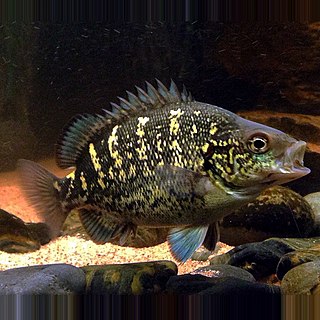
Hephaestus carbo, the coal grunter or black grunter, is a species of freshwater ray-finned fish, a grunter from the family Terapontidae. It is endemic to rivers in northern Australia.

Terapon theraps, the largescaled terapon, banded grunter, banded trumpeter, flagtail grunter, flagtail trumpeter, large-scaled grunter-perch, Northern grunter and spiky trumpeter, is a species of marine ray-finned fish, a grunter from the family Terapontidae. This species has a wide distribution in the Indo-Pacific region.

Pelates quadrilineatus, also known as the trumpeter perch or fourlined terapon, is a species of ray-finned fish in the family Terapontidae, the grunters. It occurs in the western Indo-Pacific region, and also in the eastern Mediterranean Sea, having arrived there by passing through the Suez Canal.

Terapon puta, the spiny-checked grunter, three-lined grunter, small-scaled banded grunter, small-scaled terapon, squeaking perch or two-lined grunter, is a species of fish from the Indo-Pacific region, it is a member of the grunter family, Terapontidae. It has also spread into the eastern Mediterranean Sea from the Red Sea through the Suez Canal, a process known as Lessepsian migration.
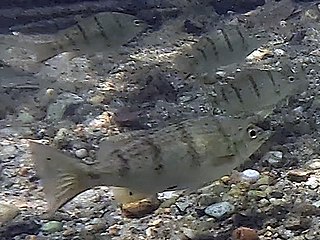
Amniataba is a genus of fish in the family Terapontidae, that includes three species, with two being found in Oceania, and one in the Western Central Pacific.

The sea trumpeter is a species of marine ray-finned fish, a grunter from the family Terapontidae. It is endemic to the southeastern Indian Ocean off the southwestern coats of Australia.
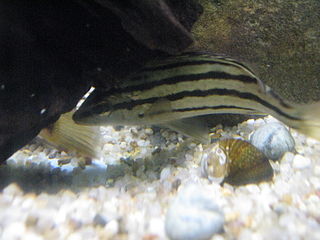
The sharpbeak terapon is a species of ray-finned fish, a grunter from the family Terapontidae. It is found in the coastal waters of Asia from southern Japan to the Philippines.




















